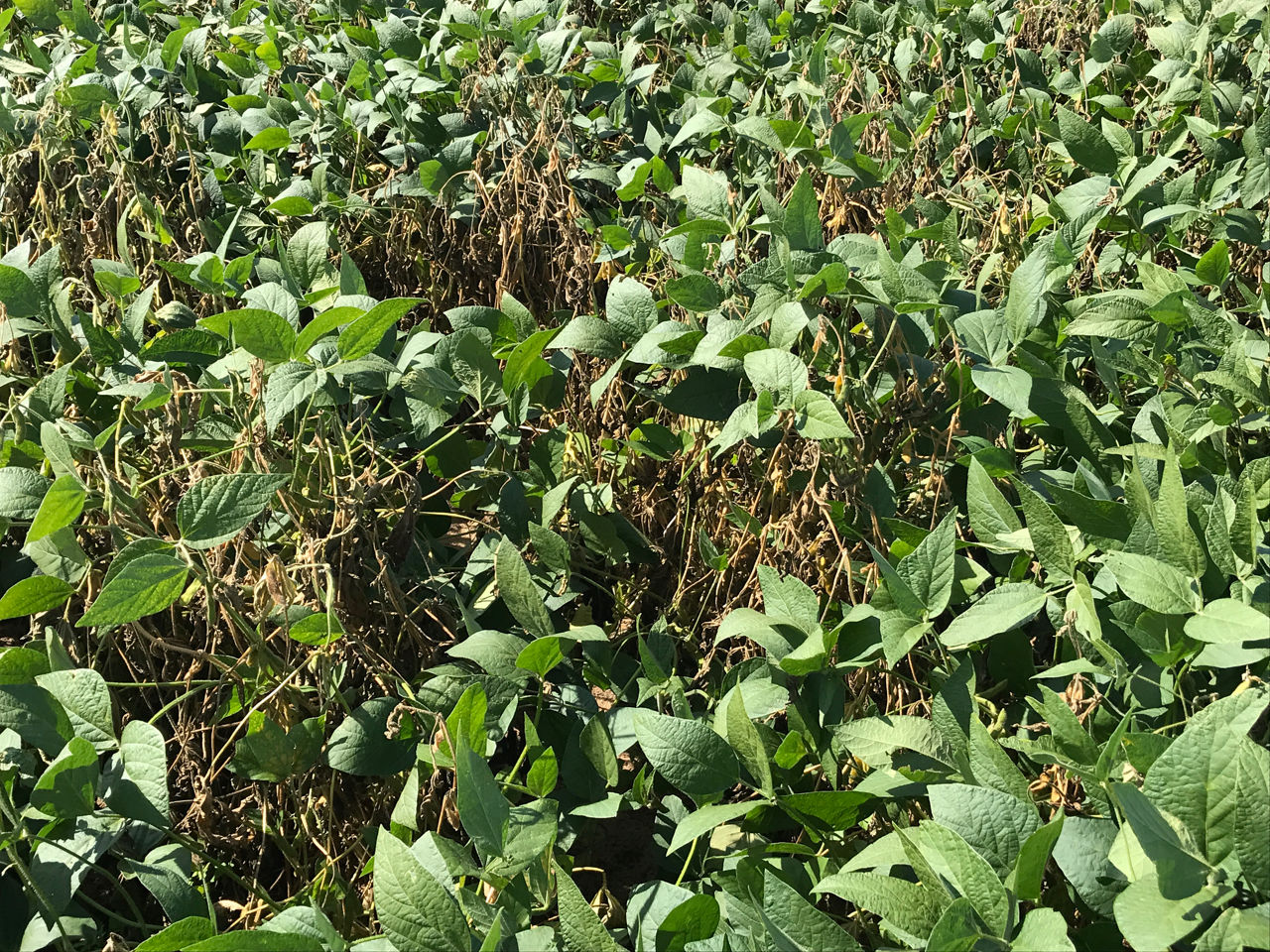3 MIN READ
Managing White Mold During the Postharvest Season
November 10, 2023
- During harvest, many producers may observe soybean fields with Sclerotinia stem rot (white mold). While the damage is already done for this growing season, there are some tactics that can be used to reduce the risk of future white mold losses.
Rarely is an entire soybean field infected with white mold. Commonly, the infection is concentrated in lower areas of the field, portions shaded by shelterbelt trees, and sometimes in the field’s entry point. Harvesting can cause sclerotia (the overwintering structures of the fungal pathogen) to become lodged in the combine, thus spreading them to other areas of the field or transporting them to other fields. If the field has a substantial amount of white mold, cleaning the combine may help prevent the spread of the sclerotia to other fields.1 Estimating the level of infection in each field and then harvesting the most heavily infected field last may also prevent the spread of sclerotia.

Most producers plant soybean in rotation with other crops, particularly corn. Since soybean is usually harvested first, failing to clean the combine after soybean harvest can move sclerotia to fields where corn is being harvested. If these fields are planted to soybean the next year, the introduced sclerotia could raise the fields’ risk for infection. If the combine will not be cleaned after harvesting white mold-infected soybean and prior to harvesting corn, consider harvesting the corn in a specific area, such as along one field margin. By noting which area was harvested with a potentially sclerotia-contaminated combine, an application of fungicide could be focused in that area in the next growing season, which would reduce the cost compared to a fungicide application across the entire field.
Harvesting soybean straw
Soybean straw or residue can be used for livestock bedding; however, if the residue is from a field heavily infected with white mold it may contain substantial amounts of sclerotia. Returning the residue back to the same field would prevent inoculating other fields with the disease.
Tillage
Leaving sclerotia on the soil surface, thus exposing them to the elements, increases their decay rate.2,3 Aggressive tillage of soybean stubble infested with white mold can result in burying the sclerotia, thereby protecting them from exposure and enhancing their survival. If subsequent tillage brings them back to within 2 inches (5 cm) of the soil surface, the sclerotia may germinate and release infectious spores. One management strategy for using tillage to reduce white mold is to bury the infested soybean stubble after harvest when the infection rate is high. Then in the subsequent cropping season, tillage is limited to minimize the return of sclerotia to within 2 inches (5 cm) of the soil surface.
Cover crops4
The use of small grain cover crops grown with soybean can stimulate earlier emergence of apothecia compared to soybean grown alone, which may potentially lower white mold incidence. While planting small grain cover crops may help reduce white mold, the downside is that the cover crops must be managed so as to not impact the soybean crop via competition for nutrients and moisture. Alternatively, the use of a fall established rye cover crop that is terminated in the spring with a roller-crimper may reduce white mold. The mat of rye left after roller-crimping produces a dark environment at the soil surface that is not conducive for complete apothecial development. The thick rye mat may also function as a physical barrier limiting ascospore release and movement.
Biological control
Coniothyrium minitans is a fungal parasite of white mold sclerotia that is used as a biological control agent for the disease,4 which is active in the top 2 inches (5 cm) of the soil. There are two commercial formulations of this biological control agent, Contans® WG and KONI®. They can be applied after harvest in the fall as a spray over the crop residue. For the best control use light tillage, no deeper than 2 inches (5 cm). Research conducted at a Michigan State University greenhouse found that the number of sclerotia was reduced by 50% after Contans® WG was applied, and the number of apothecia (spore-bearing structures that form on sclerotia) was reduced by 81.2%.5
Conclusions
White mold is a disease best managed by using cultural tactics to reduce the incidence of the disease; use of tolerant soybean products, wider row spacing, lower planting populations, crop rotation, nutrient management, fungicide, and irrigation management are all things that can reduce the incidence of white mold disease in-season.6 Harvest and after harvest tactics are focused on preventing infection in the following growing season and preventing the spread of the pathogen to other fields.
Sources
1 Mueller, D. 2014. Managing white mold in soybean. Iowa State University Extension. https://crops.extension.iastate.edu/cropnews/2014/07/managing-white-mold-soybean
2 Yang, X.B. 2010. Effects of fall tillage on soybean white mold and sudden death syndrome in 2011. Iowa State University Extension. https://crops.extension.iastate.edu/cropnews/2010/11/effects-fall-tillage-soybean-white-mold-and-sudden-death-syndrome-2011
3 Jardine, D. 2020. White mold. https://soybeanresearchinfo.com/soybean-disease/white-mold/
4 Smith, D., Sisson, A., Chilvers, M., Kabbage, M., McCaghey, M., and Willbur, J. 2022. White mold of soybean web book. Crop Protection Network. CPN 1026. https://cropprotectionnetwork.org/web-books/white-mold-of-soybean
5 DeDecker, J. 2014. Biological products available for late season white mold Treatment. Michigan State University Extension. https://www.canr.msu.edu/news/biological_products_available_for_late_season_white_mold_treatment
6 Mueller, D. et al. White mold. Crop Protection Network. CPN-1005. https://crop-protection-network.s3.amazonaws.com/publications/cpn-1005-white-mold.pdf
1311_154700